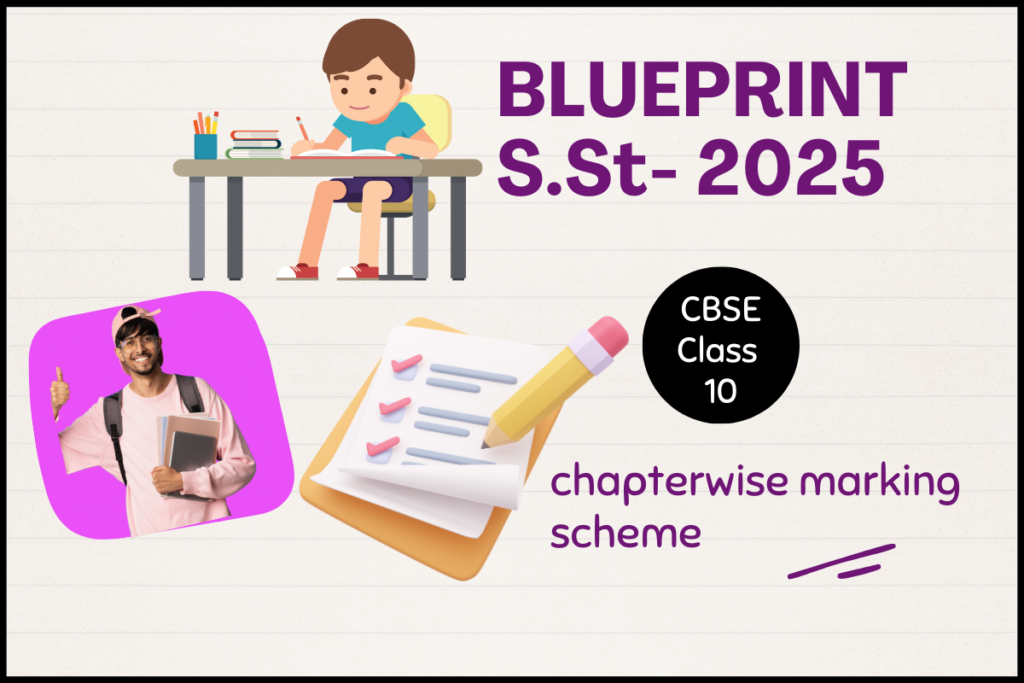
Blueprint of SST Class 10
Preparing for the Class 10 Social Science (SST) board exams can feel like an uphill battle, but a detailed understanding of the SST Class 10 blueprint can make your preparation more streamlined and efficient. Let’s dive deep into this essential study tool to ensure you excel in your exams.
Table of Contents
What is the SST Blueprint?
The SST blueprint is a structured framework that outlines the distribution of marks, question types, and topics for the board examination. It serves as a guide to understand which areas require more focus and helps in efficient time management.
Why is the Blueprint Essential for Class 10 Students?
- Clarity on Mark Distribution: It tells you how much weightage each section carries.
- Efficient Revision Planning: Helps you prioritize high-scoring topics.
- Confidence Booster: Knowing the exam pattern reduces stress during preparation.
Components of the Class 10 SST Blueprint
1. Divisions of the SST Syllabus
The Class 10 SST syllabus is divided into four key subjects:
- History
- Geography
- Political Science
- Economics
Each subject contributes differently to the total marks, so it’s crucial to know the distribution.
2. Mark Distribution for Each Subject
- History: 20 Marks
- Geography: 20 Marks
- Political Science: 20 Marks
- Economics: 20 Marks
- Map Work: 5 Marks
This totals to 80 marks, with the remaining 20 allocated for internal assessment.
3. Question Paper Structure
The SST question paper is divided into different types of questions:
- Objective Type Questions (MCQs): 1 mark each.
- Short Answer Questions: 3 marks each.
- Long Answer Questions: 5 marks each.
This mix ensures that students are tested on both conceptual understanding and analytical abilities.
Detailed Analysis of Each Subject in the Blueprint
History: Important Topics and Their Weightage
Key chapters like The Rise of Nationalism in Europe and India’s Struggle for Independence are heavily weighted. Focus on:
- Timeline-based questions.
- The significance of historical events.
Geography: Key Chapters and Marking Scheme
Geography questions often include maps, so practicing them is essential. Key chapters:
- Resources and Development
- Water Resources
- Agriculture
Political Science: High-Scoring Areas to Focus On
Political Science is conceptual, with questions often focusing on real-world applications. Prioritize:
- Power Sharing
- Democracy and Diversity
- Outcomes of Democracy
Economics: Most Frequently Asked Questions
Economics can be high-scoring if concepts are clear. Focus on:
- Sectors of the Indian Economy
- Money and Credit
- Globalization and the Indian Economy
Strategies to Ace SST Using the Blueprint
1. Time Management Based on Blueprint Insights
Divide your study hours based on subject weightage. Spend more time on history and geography as they have detailed chapters.
2. Prioritizing High-Weightage Topics
Identify chapters with maximum marks and prepare them first. Use flowcharts and notes for revision.
3. How to Practice Effectively with Sample Papers
Solve at least 5–10 sample papers to get familiar with the exam pattern. Focus on completing the paper within the allotted time.
Common Mistakes Students Make
1. Overlooking Low-Weightage Topics
Even low-weightage chapters can have tricky questions. Don’t skip them entirely.
2. Ignoring NCERT Exercises
The board exam is based on NCERT. Ensure you complete all exercises and examples.
Conclusion
The SST Class 10 blueprint is your ultimate guide to acing the exam. By understanding the mark distribution and focusing on high-priority topics, you can streamline your preparation. With consistent effort, proper planning, and adherence to the blueprint, success is just around the corner.
FAQs
1. What is the SST Class 10 Blueprint?
The SST Class 10 blueprint outlines the exam structure, including marks distribution and question types.
2. Where Can I Access the Official Blueprint?
You can find it on the official CBSE website or consult your teacher for guidance.
3. How Should I Use the Blueprint for Revision?
Prioritize high-weightage topics and practice sample papers based on the blueprint.
4. Is NCERT Sufficient for Class 10 SST Preparation?
Yes, NCERT is the primary source for board exams, but supplementary materials can enhance your preparation.
5. Are Sample Papers Based on the Blueprint?
Yes, most sample papers are designed to follow the blueprint’s structure and syllabus.
